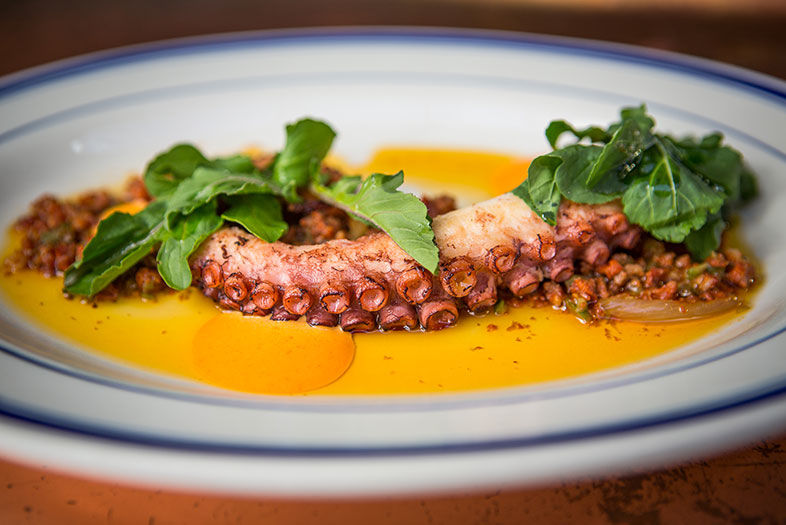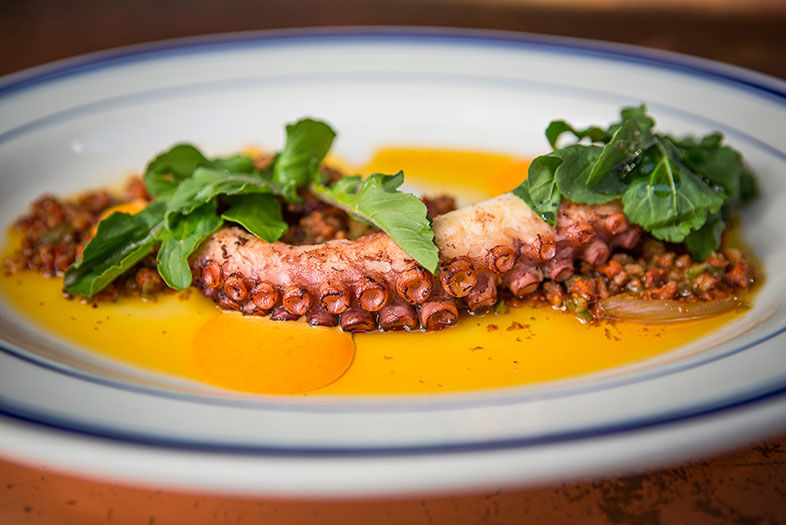In the ’70s, America was a place where dad could drive down the freeway smoking Marlboros with the windows up, his toddler not only not wearing a seatbelt, but also sitting on dad’s lap (“My baby boy wants to steer!”).
Today, thanks to science and public awareness campaigns, America has become a very nice, safe place to bore ourselves to death. Don’t drink. Don’t smoke. Don’t have sex with people who have lots of sex, even though those people are generally the funnest people to have sex with.
We’re a country of rules, disclaimers, handrails, airbags, pacemakers, and bumper bowling—we protect ourselves against the emotional trauma of a gutter ball.
Legislated into well-preserved submission, we look for adventure in other areas. Food is the most common arena for our pent-up adventurism. And right now, octopus is the most common dare food on San Diego’s plate. It’s become the seared ahi for the post-Andrew Zimmern generation, showing up in salads, over potatoes, simply grilled, as sashimi, or mixed in with pasta or seafood stews.
“We’re running into a shortage because so many restaurants are serving it,” one high-end seafood supplier recently told me.
Just look at it. Whereas a fish filet looks like an amorphous steak, that tentacle looks like the exact thing it is: amputation. Little alien mouths protruding from a centralized alien limb. Tentacles are the realm of nightmare and myth. They capsized ancient boats and made up the scary skirt on the sea witch in The Little Mermaid.
We’ve been working toward this for a while, starting with fried calamari. Calamari is squid, a soft-bodied cephalopod cousin of octopus. You know that one piece of fried calamari that “bloomed” with legs? The one the more adventurous eater at the table always took with pride? Octopus is basically that, in the nude.
“Octopus is… seared ahi for the post-Andrew Zimmerman generation.”
But here’s the truth about octopus: It looks alien, but it tastes mundane. Whereas oysters taste like the ocean has sinus issues and uni tastes like fish-butter, octopus tastes like white meat. That’s why chefs have been able to convince diners to try it, and why diners don’t mind it once they do.
Japanese and Mediterranean cultures have been octopussing for centuries. In fishing villages you’ll often see divers beating octopi against the rocks, or a full octopus dangling from the clothesline to dry. Most octopi come from rocky coastlines like Portugal or Baja, Mexico. Chefs prefer them in the one- to seven-pound range, although at Kaito Sushi in Encinitas I’ve had raw baby octopus, which was challenging to swallow (their tiny heads burst in your mouth, issuing forth an ounce of oceanic brain juice).
The problem with octopus? Tenderizing the notoriously tough meat. Since its greatest reward is texture, it really thrives from a dry heat/grilling technique. But if you just threw a raw octopus on the open fire it would turn to rubber. There are countless methods of tenderizing. Mario Batali swears by boiling it with wine corks (some have debunked that as a kitchen myth).
At Ironside Fish & Oyster, chef Jason McLeod has his cooks massage it for 10 to 15 minutes—”exactly like if you had a knot in your shoulder,” he says. Then he poaches it for a long while, a method most chefs enlist to both expel excess moisture and soften the meat. Finally, he grills it on the plancha (a metal grill plate) to caramelize and lightly char the edges. He’s serving a single tentacle in a sauce of Castelvetrano olives and chorizo sauce. At Sea & Smoke, chef Matt Gordon turns to the sous vide machine, cooking it at low temp (165 degrees) for a number of hours. He serves it with ancho chile romesco sauce and a warm frisee salad with golden raisins and green olives.
“The proliferation of the Baja-Mediterranean culture in San Diego has helped push octopus onto more mainstream menus,” Gordon says.
To that end, one of the most raved-about octopus dishes is from Baja chef Javier Plascencia at Romesco. He gets his octopus from Campeche, on the Caribbean side of Baja, and boils it for 45 minutes. He finishes it off on a wood-fired grill with a lemon-chile sauce.
The ultimate effect in most of these preparations is to end with a slightly chewy interior meat, a caramelized, semisweet outer layer of skin, plus some slight char on the suckers themselves—one of the most compelling textural dishes you’ll eat.
Dare ya.

Side Dish: Octopus
Disarmingly delicious: Ironside’s octopus | Photography by Sam Wells














